Donkey Kong
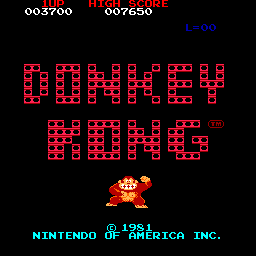 With one unprofitable flop behind it, the American branch of Nintendo has a lot riding on its second arcade game. Fortunately, it strikes gold with Donkey Kong, the coin-op which launches the careers of both Shigeru Miyamoto and a plumber named Mario (though in this game, he’s known as “Jumpman”). Nintendo is now in America to stay.
With one unprofitable flop behind it, the American branch of Nintendo has a lot riding on its second arcade game. Fortunately, it strikes gold with Donkey Kong, the coin-op which launches the careers of both Shigeru Miyamoto and a plumber named Mario (though in this game, he’s known as “Jumpman”). Nintendo is now in America to stay.
Cosmic Avenger
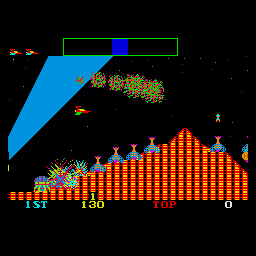 With game play similar to the coin-op hit Defender (but more detailed, colorful graphics), Universal introduces the minor arcade hit Cosmic Avenger in America. Though it never really sets earnings records, home video game rights are eventually snapped up by Coleco, which will offer a home version of Cosmic Avenger on its upcoming Colecovision console.
With game play similar to the coin-op hit Defender (but more detailed, colorful graphics), Universal introduces the minor arcade hit Cosmic Avenger in America. Though it never really sets earnings records, home video game rights are eventually snapped up by Coleco, which will offer a home version of Cosmic Avenger on its upcoming Colecovision console.
Astro Blaster
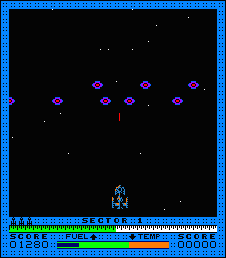 Sega introduces Astro Blaster to an arcade scene already awash in space shoot-’em-ups, but the game carves out a small niche for itself. Its greatest contribution, later on, may be in providing much of the inspiration for Activision’s home video game hit Megamania.
Sega introduces Astro Blaster to an arcade scene already awash in space shoot-’em-ups, but the game carves out a small niche for itself. Its greatest contribution, later on, may be in providing much of the inspiration for Activision’s home video game hit Megamania.
Space Odyssey
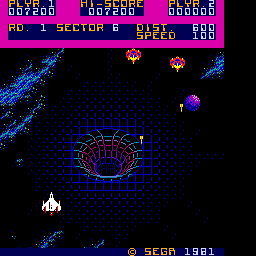 Sega releases the arcade game Space Odyssey in American arcades. With its depiction of Schwarzchild radius-style black holes scrolling under the player’s spaceship, this is among the first arcade video games with isometric 3-D graphics.
Sega releases the arcade game Space Odyssey in American arcades. With its depiction of Schwarzchild radius-style black holes scrolling under the player’s spaceship, this is among the first arcade video games with isometric 3-D graphics.
Venture
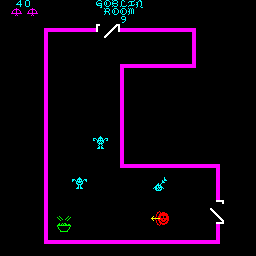 Exidy’s swashbuckling coin-op video game Venture arrives in arcades, letting players control the actions of the bow-and-arrow-shooting treasure hunter, Winky. The game’s unique structure provides an early example of an “interactive graphical menu” letting players choose which treasure room to plunder next – but a choice has to be made quickly, in real time, because there are still monsters that can kill Winky on the menu screen.
Exidy’s swashbuckling coin-op video game Venture arrives in arcades, letting players control the actions of the bow-and-arrow-shooting treasure hunter, Winky. The game’s unique structure provides an early example of an “interactive graphical menu” letting players choose which treasure room to plunder next – but a choice has to be made quickly, in real time, because there are still monsters that can kill Winky on the menu screen.
Warp Warp
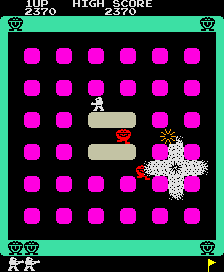 Better known for making jukeboxes and speakers, Rock-Ola dips its toes into the video game industry by releasing Warp Warp in the United States. The arcade game, originated in Japan by Namco, features cute, colorful characters in a maze setting, not entirely unlike Pac-Man, but fails to catch on in American arcades.
Better known for making jukeboxes and speakers, Rock-Ola dips its toes into the video game industry by releasing Warp Warp in the United States. The arcade game, originated in Japan by Namco, features cute, colorful characters in a maze setting, not entirely unlike Pac-Man, but fails to catch on in American arcades.
Activision class of ’81
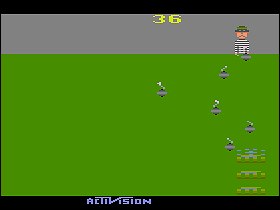 Activision releases a trio of cartridges for the Atari VCS home video game system: Kaboom!, Tennis and Laser Blast. Kaboom!, inspired by the ’70s arcade game Avalanche, proves to be the fast favorite of the three games.
Activision releases a trio of cartridges for the Atari VCS home video game system: Kaboom!, Tennis and Laser Blast. Kaboom!, inspired by the ’70s arcade game Avalanche, proves to be the fast favorite of the three games.
Missile Command
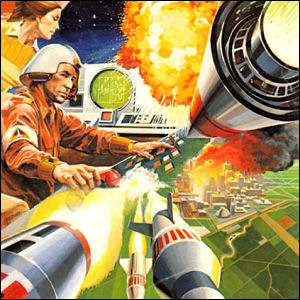 Atari releases the home version of Missile Command as a cartridge for the Atari 2600. The manual included with the game explains the missile attack as the product of an alien invasion, not Reagan-era Cold War tensions. Though the cartridge is an instant best-seller, its programmer receives a reward that convinces him to look for work somewhere other than Atari.
Atari releases the home version of Missile Command as a cartridge for the Atari 2600. The manual included with the game explains the missile attack as the product of an alien invasion, not Reagan-era Cold War tensions. Though the cartridge is an instant best-seller, its programmer receives a reward that convinces him to look for work somewhere other than Atari.
Lock ‘n’ Chase
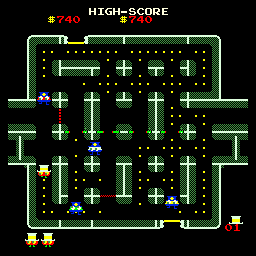 Data East releases the arcade video game Lock ‘n’ Chase in the United States. Though bearing some distinctive differences from Pac-Man, the game gets lost in a glut of Pac-Man knock-off coin-ops also in circulation.
Data East releases the arcade video game Lock ‘n’ Chase in the United States. Though bearing some distinctive differences from Pac-Man, the game gets lost in a glut of Pac-Man knock-off coin-ops also in circulation.
Video Pinball
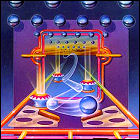 Atari releases Video Pinball as a cartridge for the Atari 2600. Though sharing the same name as an earlier Atari arcade game, the home edition is a somewhat more elaborate simultaion of pinball.
Atari releases Video Pinball as a cartridge for the Atari 2600. Though sharing the same name as an earlier Atari arcade game, the home edition is a somewhat more elaborate simultaion of pinball.
Scramble
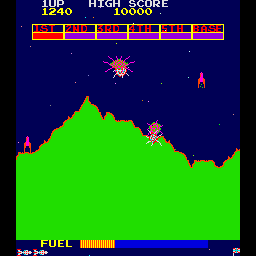 American pinball manufacturer Stern Electronics releases a video game licensed from Japanese game maker Konami Industries, Scramble. Though it earns a small but loyal following among arcade gamers, Scramble‘s true claim to history will be in setting a legal precedent: it later becomes the first video game whose code is copyrighted as a literary work in its own right as Stern seeks to take down bootleggers who copy the game’s program and brazenly market it under the same name.
American pinball manufacturer Stern Electronics releases a video game licensed from Japanese game maker Konami Industries, Scramble. Though it earns a small but loyal following among arcade gamers, Scramble‘s true claim to history will be in setting a legal precedent: it later becomes the first video game whose code is copyrighted as a literary work in its own right as Stern seeks to take down bootleggers who copy the game’s program and brazenly market it under the same name.
Space Panic
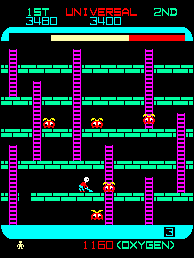 Universal (a video game manufacturer unrelated to the Hollywood studio of the same name) introduces the minor arcade classic Space Panic, a game which goes down in history primarily for inspiring the home computer game hit Lode Runner later in the decade. Space Panic is also the first arcade game in which success is dependent on the player climbing ladders, a year before the release of Donkey Kong.
Universal (a video game manufacturer unrelated to the Hollywood studio of the same name) introduces the minor arcade classic Space Panic, a game which goes down in history primarily for inspiring the home computer game hit Lode Runner later in the decade. Space Panic is also the first arcade game in which success is dependent on the player climbing ladders, a year before the release of Donkey Kong.
Defender
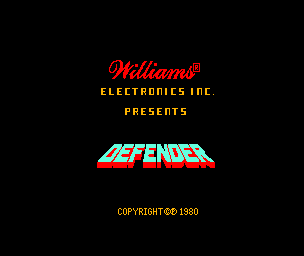 After a mad last-minute rush to prepare it for display at the 1980 Amusement Machine Operators of America (AMOA) trade show, Williams Electronics debuts what will become its most successful arcade game, Defender. With a more complex control panel than nearly any video game since Computer Space, Defender is ignored at AMOA, only to become a top earner in arcades (and a source of bragging rights for those who master the control scheme).
After a mad last-minute rush to prepare it for display at the 1980 Amusement Machine Operators of America (AMOA) trade show, Williams Electronics debuts what will become its most successful arcade game, Defender. With a more complex control panel than nearly any video game since Computer Space, Defender is ignored at AMOA, only to become a top earner in arcades (and a source of bragging rights for those who master the control scheme).
Alien Invaders – Plus!
 The Odyssey2 video game console’s answer to Space Invaders, Alien Invaders – Plus!, hits stores. Though patterned after the familiar layout of the arcade game, the Odyssey edition offers some interesting variations, especially once the player runs out of protective shields.
The Odyssey2 video game console’s answer to Space Invaders, Alien Invaders – Plus!, hits stores. Though patterned after the familiar layout of the arcade game, the Odyssey edition offers some interesting variations, especially once the player runs out of protective shields.
Radar Scope
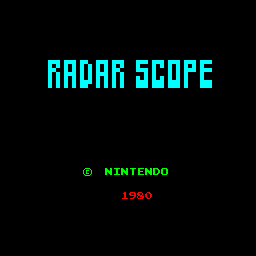 Having just opened up its American branch, Japanese video game manufacturer Nintendo introduces its first arcade game, the virtually-unknown space shooter Radar Scope. The game fails to make a splash, and many of the Radar Scope cabinets in Nintendo’s warehouse are later converted into their next (and far more profitable) game, which involves a plumber saving a woman from a gorilla.
Having just opened up its American branch, Japanese video game manufacturer Nintendo introduces its first arcade game, the virtually-unknown space shooter Radar Scope. The game fails to make a splash, and many of the Radar Scope cabinets in Nintendo’s warehouse are later converted into their next (and far more profitable) game, which involves a plumber saving a woman from a gorilla.
Crazy Climber
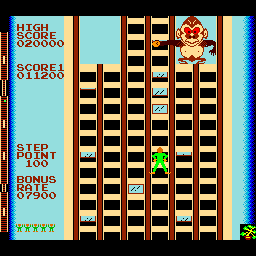 Boasting a tricky dual-joystick control scheme allowing players fine-tuned control over their on-screen character’s movements, Crazy Climber invades arcades in the States following its introduction in Japan. Cheerfully urging players to “Go for it!”, the cult arcade classic makes splattering on the sidewalks seem fun.
Boasting a tricky dual-joystick control scheme allowing players fine-tuned control over their on-screen character’s movements, Crazy Climber invades arcades in the States following its introduction in Japan. Cheerfully urging players to “Go for it!”, the cult arcade classic makes splattering on the sidewalks seem fun. 
Berzerk
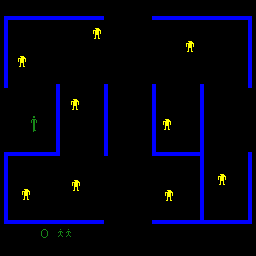 Pinball manufacturer Stern Electronics establishes a firm foothold as a maker of video games with the paranoia-inducing coin-op Berzerk. Featuring voice synthesis disturbingly similar to the voices of Battlestar Galactica’s Cylon warriors, and a bouncy, smiling killer named Evil Otto who appears with little or no warning, Berzerk becomes a cult classic (even meriting a serenade on Buckner & Garcia’s 1982 album Pac-Man Fever).
Pinball manufacturer Stern Electronics establishes a firm foothold as a maker of video games with the paranoia-inducing coin-op Berzerk. Featuring voice synthesis disturbingly similar to the voices of Battlestar Galactica’s Cylon warriors, and a bouncy, smiling killer named Evil Otto who appears with little or no warning, Berzerk becomes a cult classic (even meriting a serenade on Buckner & Garcia’s 1982 album Pac-Man Fever).
Battlezone
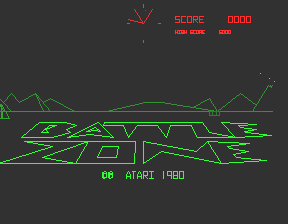 Atari releases the arcade game Battlezone in the United States, bringing back Tank’s double joysticks but putting the player in the tank in a first-person perspective (complete with “shattered glass” is enemy artillery takes the player’s tank out of commission).
Atari releases the arcade game Battlezone in the United States, bringing back Tank’s double joysticks but putting the player in the tank in a first-person perspective (complete with “shattered glass” is enemy artillery takes the player’s tank out of commission).
Star Castle
 Cinematronics releases the cult classic arcade game Star Castle, a vector graphics game sending players on a mission to create a tiny vulnerability in a space station’s colorful rotating defense shields. Once its shields have been penetrated, a well timed shot can destroy the enemy fortress.
Cinematronics releases the cult classic arcade game Star Castle, a vector graphics game sending players on a mission to create a tiny vulnerability in a space station’s colorful rotating defense shields. Once its shields have been penetrated, a well timed shot can destroy the enemy fortress.
Asteroids Deluxe
 Atari releases the arcade game Asteroids Deluxe in the United States, adding shields and other twists to the familiar game play of the smash hit Asteroids.
Atari releases the arcade game Asteroids Deluxe in the United States, adding shields and other twists to the familiar game play of the smash hit Asteroids.
Armor… Attack
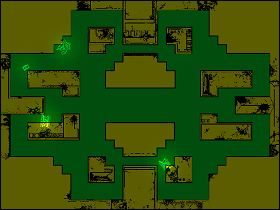 Cinematronics’ vector graphics arcade wargame Armor… Attack hits the market, pitting players against armed ground vehicles and enemy helicopters. (Of course, players have to insert their entire defense budget of 25 cents first, and even then, it’s still down to reflexes.)
Cinematronics’ vector graphics arcade wargame Armor… Attack hits the market, pitting players against armed ground vehicles and enemy helicopters. (Of course, players have to insert their entire defense budget of 25 cents first, and even then, it’s still down to reflexes.)
Moon Cresta
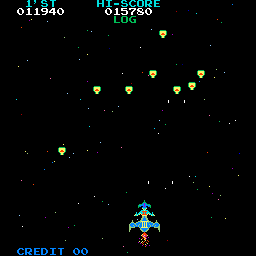 Japanese import Moon Cresta bursts into American arcades, challenging veterans of previous slide-and-shoot space games to dodge its never-ending waves of multi-colored invaders. Also on display is the best metaphor ever for “extra lives”: the player has to assemble a three-stage rocket to fight off the attackers.
Japanese import Moon Cresta bursts into American arcades, challenging veterans of previous slide-and-shoot space games to dodge its never-ending waves of multi-colored invaders. Also on display is the best metaphor ever for “extra lives”: the player has to assemble a three-stage rocket to fight off the attackers.
Astro Invader
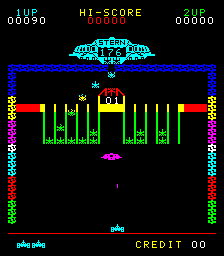 Chicago-based pinball manufacturer Stern makes one of its earliest forays into the booming video game industry with an altered version of the hit game Space Invaders, retitled Astro Invader. The game proves successful enough for Stern to invest in development of original games.
Chicago-based pinball manufacturer Stern makes one of its earliest forays into the booming video game industry with an altered version of the hit game Space Invaders, retitled Astro Invader. The game proves successful enough for Stern to invest in development of original games.
Adventure
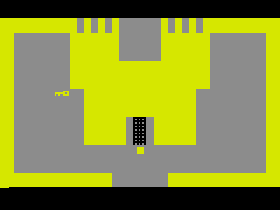 Atari releases the Adventure cartridge for the Atari VCS home video game system. Designed and programmed by Warren Robinett, Adventure is the first of its kind – a VCS game with a playing field larger than the TV screen, mapped out in the program’s memory – but later becomes better remembered for one “room” in the game’s maze which contains the programmer’s name, one of the earliest video game “Easter eggs.”
Atari releases the Adventure cartridge for the Atari VCS home video game system. Designed and programmed by Warren Robinett, Adventure is the first of its kind – a VCS game with a playing field larger than the TV screen, mapped out in the program’s memory – but later becomes better remembered for one “room” in the game’s maze which contains the programmer’s name, one of the earliest video game “Easter eggs.”
Night Driver
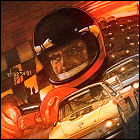 Atari releases the home version of Night Driver as a cartridge for the Atari 2600. This game is one of the few to use the console’s “paddle” controllers.
Atari releases the home version of Night Driver as a cartridge for the Atari 2600. This game is one of the few to use the console’s “paddle” controllers.
Rally-X
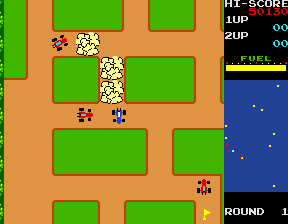 Arcade game maker Midway introduces the coin-op video game Rally-X in American arcades. The game, originated in Japan by Namco, is rolled out at a 1980 trade show for amusement and arcade machine operators alongside another Namco/Midway import, Pac-Man. With its more-accessible-to-mainstream-America race car elements, Rally-X is considered the hot favorite of the two, possibly a major hit in the making.
Arcade game maker Midway introduces the coin-op video game Rally-X in American arcades. The game, originated in Japan by Namco, is rolled out at a 1980 trade show for amusement and arcade machine operators alongside another Namco/Midway import, Pac-Man. With its more-accessible-to-mainstream-America race car elements, Rally-X is considered the hot favorite of the two, possibly a major hit in the making.
Pac-Man arrives in America
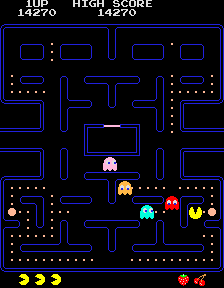 Under license from Namco, the game’s Japanese originators, Midway Manufacturing introduces the obsession that is Pac-Man to American arcades. Titled Puck-Man in its homeland (due to the yellow character’s resemblance to a round hockey puck), Midway swaps vowels for fear that vandals will turn the letter P into an F on the arcade cabinets. With its cute characters and instinctive game play, Pac-Man catches on immediately, propelling the video game industry into overdrive.
Under license from Namco, the game’s Japanese originators, Midway Manufacturing introduces the obsession that is Pac-Man to American arcades. Titled Puck-Man in its homeland (due to the yellow character’s resemblance to a round hockey puck), Midway swaps vowels for fear that vandals will turn the letter P into an F on the arcade cabinets. With its cute characters and instinctive game play, Pac-Man catches on immediately, propelling the video game industry into overdrive.
 Sega releases the arcade game
Sega releases the arcade game 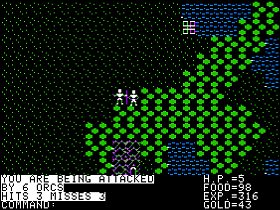 California Pacific Computer releases the computer role playing game game
California Pacific Computer releases the computer role playing game game